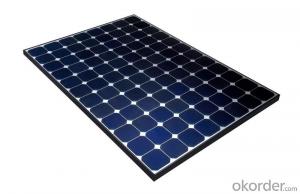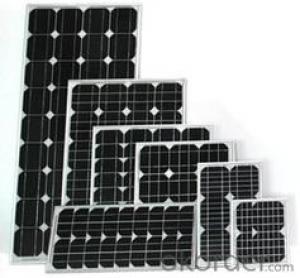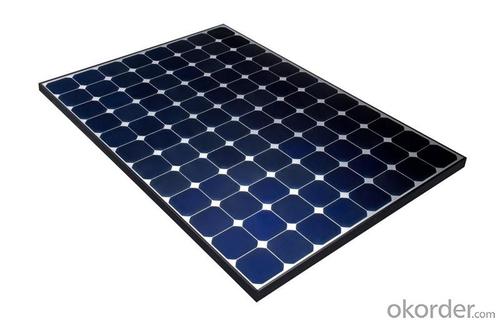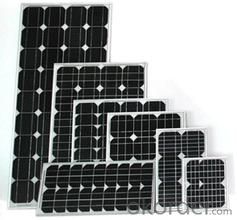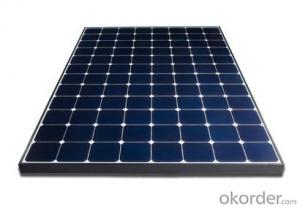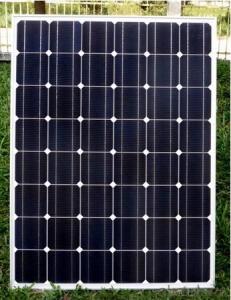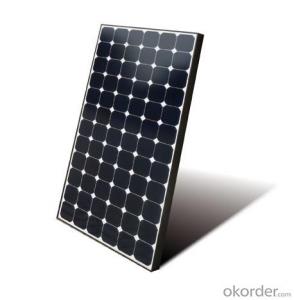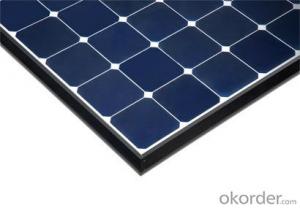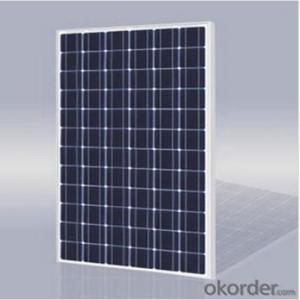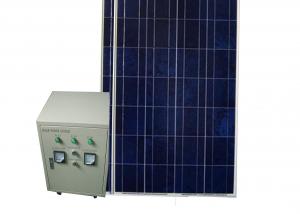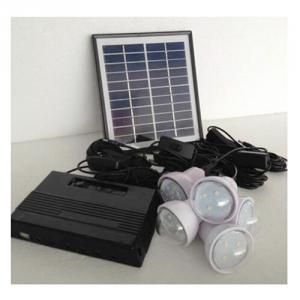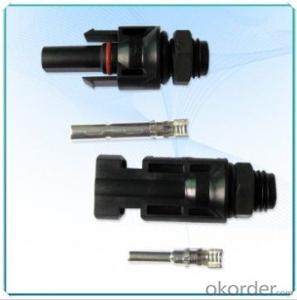Portable Solar Energy Systems - CNBM On Grid System 4000W with Certificate UL, TUV, CE
- Loading Port:
- Shanghai
- Payment Terms:
- TT OR LC
- Min Order Qty:
- 100 watt
- Supply Capability:
- 1000 watt/month
OKorder Service Pledge
OKorder Financial Service
You Might Also Like
Specification
CNBM On Grid System 4000W with Certificate UL TUV CE
Product description
Connection of the photovoltaic power system can be done only through an interconnection agreement between the consumer and the utility company. The agreement details the various safety standards to be followed during the connection.[4]
Systems such as Net Metering and Feed-in Tariff which are offered by some system operators, can offset a customers electricity usage costs. In some locations though, grid technologies cannot cope with distributed generation feeding into the grid, so the export of surplus electricity is not possible and that surplus is earthed.
Grid-connected PV systems are comparatively easier to install as they do not require a battery system.[1][6]
Grid interconnection of photovoltaic (PV) power generation systems has the advantage of effective utilization of generated power because there are no storage losses involved.[7]
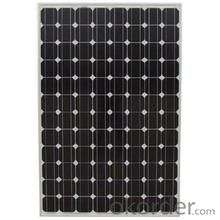
Application
Industrial
Commercial
Residential
Feature
Residential, grid-connected rooftop systems which have a capacity more than 10 kilowatts can meet the load of most consumers.[2] They can feed excess power to the grid where it is consumed by other users. The feedback is done through a meter to monitor power transferred. Photovoltaic wattage may be less than average consumption, in which case the consumer will continue to purchase grid energy, but a lesser amount than previously. If photovoltaic wattage substantially exceeds average consumption, the energy produced by the panels will be much in excess of the demand. In this case, the excess power can yield revenue by selling it to the grid. Depending on their agreement with their local grid energy company, the consumer only needs to pay the cost of electricity consumed less the value of electricity generated. This will be a negative number if more electricity is generated than consumed.[3] Additionally, in some cases, cash incentives are paid from the grid operator to the consumer.
Packaging
With carton and box
- Q: How do solar energy systems affect the resale value of a home?
- Solar energy systems can have a positive impact on the resale value of a home. Studies have shown that homes equipped with solar panels tend to sell faster and at a higher price compared to homes without them. This is because solar energy systems offer numerous benefits, such as reduced energy costs, potential tax incentives, and a smaller environmental footprint. Additionally, as renewable energy becomes increasingly popular, homes with solar panels are often seen as more desirable to buyers, making them a valuable investment.
- Q: What is the impact of dust storms on solar panels?
- Dust storms can have a significant impact on solar panels. The accumulation of dust and debris on the surface of solar panels can block sunlight from reaching the photovoltaic cells, reducing their efficiency and overall electricity generation. Dust particles on the surface of the panels create a barrier that prevents sunlight from penetrating and being converted into electricity. This can result in a decrease in power output and a decrease in the overall performance of the solar panel system. Furthermore, dust storms can also cause physical damage to the panels. Strong winds during a dust storm can carry abrasive particles that can scratch or chip the surface of the panels, leading to long-term degradation and reduced efficiency. The accumulation of dust and debris can also increase the temperature of the panels, which can further decrease their efficiency. To mitigate the impact of dust storms on solar panels, regular cleaning and maintenance are essential. Cleaning the panels periodically to remove dust and debris can help maintain their efficiency and maximize electricity generation. Additionally, installing panel tilt systems or incorporating self-cleaning technologies can also minimize the impact of dust storms by effectively shedding off or preventing dust accumulation. Overall, dust storms can have a detrimental impact on solar panels, reducing their efficiency and potentially causing physical damage. However, with proper maintenance and cleaning practices, the negative effects of dust storms can be minimized, allowing solar panels to continue generating clean and sustainable energy.
- Q: Can solar energy systems be used in remote locations without access to the grid?
- Yes, solar energy systems can be used in remote locations without access to the grid. Solar panels can generate electricity from sunlight, which can then be stored in batteries for later use. This allows for off-grid power supply in remote areas, making solar energy a viable and sustainable option for providing electricity in such locations.
- Q: Can solar energy systems be installed on agricultural land?
- Yes, solar energy systems can be installed on agricultural land. In fact, installing solar panels on farmland can provide dual benefits by generating clean energy while still allowing for agricultural activities to continue. This practice, known as agrivoltaics or solar farming, has gained popularity as it maximizes land use efficiency and promotes sustainable practices.
- Q: What is the role of energy management systems in a solar energy system?
- Energy management systems play a crucial role in a solar energy system by efficiently managing and optimizing the generation, storage, and consumption of solar energy. These systems are responsible for monitoring and controlling various components of the solar energy system, ensuring that the energy produced by the solar panels is utilized effectively. One of the primary functions of an energy management system is to regulate the flow of electricity between the solar panels, the energy storage system (such as batteries), and the connected loads. This is done by constantly monitoring the energy production and consumption levels, and making adjustments to ensure that the system operates at its maximum efficiency. Energy management systems also provide real-time data and analytics regarding the performance of the solar energy system. This information includes details about the energy generation, consumption patterns, and the overall system efficiency. By analyzing this data, users can identify areas for improvement and make necessary adjustments to optimize the system's performance. In addition, energy management systems enable remote monitoring and control of the solar energy system. This allows users to access and manage the system from anywhere, making it convenient to monitor energy production, consumption, and storage levels. It also enables users to remotely control and manage the system, such as adjusting settings or turning off certain loads during peak energy consumption periods. Furthermore, energy management systems play a crucial role in maximizing the utilization of solar energy by prioritizing the use of self-generated energy. These systems can be programmed to automatically direct excess energy produced by the solar panels towards charging the energy storage system, rather than exporting it to the grid. This feature ensures that the energy generated by the solar panels is stored and utilized efficiently, reducing dependency on the grid and maximizing the benefits of solar energy. Overall, energy management systems are essential components of a solar energy system as they provide efficient monitoring, control, and optimization of energy generation, storage, and consumption. By effectively managing the flow of electricity and providing real-time data, these systems enhance the overall performance and efficiency of the solar energy system, while also allowing for remote monitoring and control.
- Q: Can solar energy systems be used for space heating?
- Yes, solar energy systems can be used for space heating. Solar thermal systems can capture and convert sunlight into heat energy, which can then be used to heat spaces in buildings. These systems typically involve solar collectors that absorb solar radiation and transfer the heat to a fluid or air, which is then circulated through the building to provide heating. Solar energy can be a cost-effective and sustainable solution for space heating, particularly in areas with abundant sunshine.
- Q: Can solar energy systems be used for agricultural applications?
- Yes, solar energy systems can be used for agricultural applications. Solar panels can power various agricultural processes such as irrigation systems, livestock watering, grain drying, and crop cultivation. Additionally, solar energy can be harnessed for powering greenhouses, providing heat and lighting for plant growth. Utilizing solar energy in agriculture offers sustainable and cost-effective solutions, reducing dependence on traditional energy sources and minimizing environmental impact.
- Q: Can solar energy systems be integrated into building materials, such as solar roof tiles?
- Solar energy systems can indeed be incorporated into building materials, and one popular instance of this is the utilization of solar roof tiles. These tiles, also referred to as solar shingles or solar slates, have been meticulously designed to resemble conventional roofing materials while simultaneously harnessing solar energy. Constructed with photovoltaic cells that convert sunlight into electricity, these specialized tiles have numerous advantages over traditional solar panels. One of the primary benefits of solar roof tiles is their seamless integration with a building's overall aesthetics, resulting in a more visually appealing structure. This harmonious blend into the building's structure allows for a more cohesive design, particularly in regions where stringent architectural guidelines are in effect. Moreover, solar roof tiles can be installed on both new and existing buildings, providing a flexible and adaptable solution. Another advantage of solar roof tiles lies in their ability to generate electricity while exhibiting durability and resistance to harsh weather conditions. These tiles are specifically designed to withstand various elements, including rain, snow, and wind. Additionally, solar roof tiles are typically manufactured using high-quality materials, ensuring a longer lifespan compared to traditional roofing materials. The integration of solar energy systems into building materials, exemplified by solar roof tiles, offers a multitude of benefits. Not only do they generate clean and renewable energy, but they also contribute to reducing reliance on fossil fuels and decreasing carbon emissions. Additionally, solar roof tiles can assist in reducing energy costs by generating electricity on-site, enabling homeowners and businesses to achieve greater energy independence. In summary, solar energy systems can indeed be incorporated into building materials, and solar roof tiles serve as a prime example of this. With their visually appealing appearance, durability, and capacity to generate energy, solar roof tiles present a promising solution for harnessing solar power while simultaneously preserving the architectural integrity of a building.
- Q: Can solar energy systems be used in powering retirement homes or assisted living facilities?
- Yes, solar energy systems can certainly be used to power retirement homes or assisted living facilities. In fact, solar energy can be a highly beneficial and cost-effective solution for these types of facilities. Retirement homes and assisted living facilities have a high energy demand due to the need for heating, cooling, lighting, and various electrical appliances. By installing solar panels on the rooftops or in suitable areas, these facilities can generate their own electricity and reduce their reliance on the grid. Solar energy systems can help these facilities reduce their operating costs significantly, as they can offset a considerable portion of their electricity bills. This is especially important for retirement homes and assisted living facilities, as they often operate on tight budgets and need to allocate resources efficiently. By harnessing solar power, these facilities can redirect the saved funds towards providing better care and services for their residents. Furthermore, solar energy systems contribute to a cleaner and greener environment. Retirement homes and assisted living facilities have a responsibility towards their residents' well-being, and by using solar power, they can reduce their carbon footprint and promote sustainability. This can have a positive impact on the health and overall quality of life for the residents. Additionally, solar energy systems can provide a reliable source of power during emergencies or power outages. Particularly in areas prone to extreme weather events, where power disruptions are more common, having a solar energy system with battery storage can ensure continuous and uninterrupted power supply to critical areas such as medical equipment, lighting, and HVAC systems. In conclusion, solar energy systems are a viable and beneficial option for powering retirement homes or assisted living facilities. They can significantly reduce operating costs, promote sustainability, and provide a reliable source of power, ultimately improving the quality of care and services provided to residents.
- Q: Can solar energy systems be used for powering food processing or packaging plants?
- Yes, solar energy systems can be used effectively for powering food processing or packaging plants. Solar panels can be installed on the rooftops or nearby open spaces of these facilities to harness the sun's energy. This renewable energy source can provide a significant portion or even the entire power required for the operations of these plants, reducing their reliance on conventional energy sources. Moreover, solar energy systems can also help these plants in achieving sustainability goals by reducing carbon emissions and lowering operational costs in the long run.
Send your message to us
Portable Solar Energy Systems - CNBM On Grid System 4000W with Certificate UL, TUV, CE
- Loading Port:
- Shanghai
- Payment Terms:
- TT OR LC
- Min Order Qty:
- 100 watt
- Supply Capability:
- 1000 watt/month
OKorder Service Pledge
OKorder Financial Service
Similar products
Hot products
Hot Searches
Related keywords
